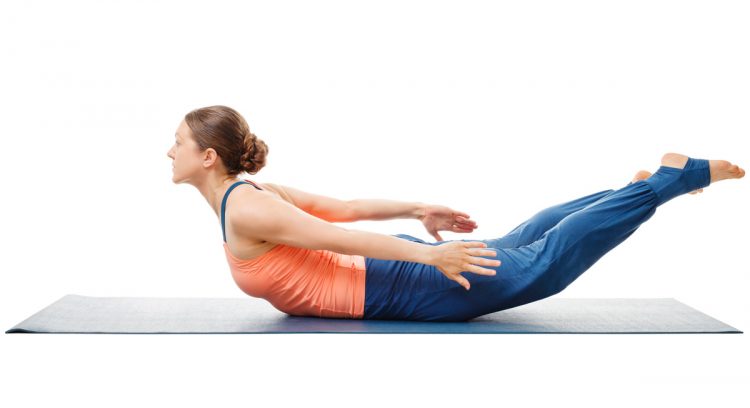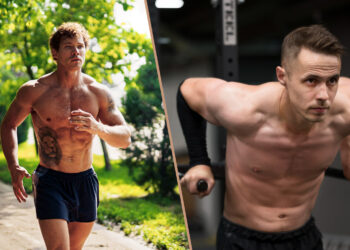If you train in a gym, you really are spoilt for choice when it comes to back exercises. With access to barbells, dumbbells, and more resistance machines than you can count, putting together an effective back workout is easy. Even a random selection of pulldowns and rows will produce a semi-effective back-building training plan.
But what if you can’t make it to the gym? Maybe you train at home or just prefer bodyweight exercises.
There are lots of calisthenic leg and core exercises and dozens of push-up variations, but how do you train your back without weights or workout machines? Pull-ups are an excellent place to start, but what else can you do?
In this article, we unleash our favorite calisthenic back workout so you can train your lats, traps, rhomboids, and erector spinae muscles anywhere and anytime.
Back Anatomy
Most people think that back means lats, but there is more to this vital body part than this well-known muscle. To build a strong and muscular back, you need to train it from all angles. That way, your back will be both wide AND thick.
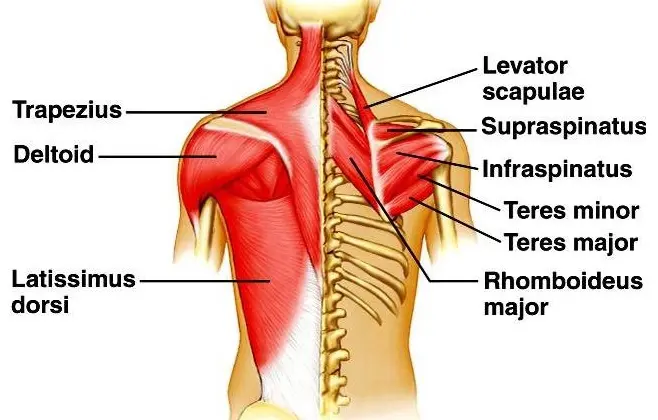
The muscles that make up your back are:
Level Up Your Fitness: Join our 💪 strong community in Fitness Volt Newsletter. Get daily inspiration, expert-backed workouts, nutrition tips, the latest in strength sports, and the support you need to reach your goals. Subscribe for free!
Latissimus dorsi – known as the lats for short, this is arguably the most well-known upper back muscle. Located on the side of your upper back, the lats are what give your upper body its width. The functions of the lats are shoulder adduction, extension, and internal rotation.
Trapezius – the traps are a diamond or trapezoid-shaped muscle that covers your upper back. There are three sets of traps fibers, each one with a different function. The upper traps are responsible for the elevation of your shoulder girdle, the middle traps pull your shoulder girdle back into retraction, while the lower traps depress your shoulder girdle.
Rhomboids – located beneath the middle traps and between your shoulder blades, the rhomboids retract your shoulder girdle.
Posterior deltoids – while the deltoids ARE your shoulder muscles, the posterior deltoid is on the rear of your body, so it could also be classed as a back muscle. Anatomical arguments aside, the posterior deltoids are involved in most back exercises, and training them will improve your appearance, posture, and performance.
Erector spinae – this is the collective name for the numerous muscles that run up either side of your spine. The primary function is the extension of your vertebral column. Strong erector spinae muscles will reduce your risk of back pain and are essential for better posture.
Now you know the names and functions of your major back muscles, it’s time to train them with our tried-and-tested calisthenic back workout.
Calisthenics Back Workout
While you don’t need any weights for this workout, and you’ll be using your body weight for resistance, you still need a few pieces of equipment to do this workout. Before you start, make sure you’ve got somewhere to do pull-ups, a waist-high bar or suspension trainer for inverted rows, an exercise mat, and a flat wall to lean against.
Do this work out once or twice a week as part of a split routine. If you do it twice, separate your workouts by a few days to allow time to recover, e.g., Monday and Thursday.
Before you start, take a moment to prepare your body for the workout that follows. Start with 5-10 minutes of light cardio, e.g., jump rope, and then do a few dynamic mobility and stretching exercises for your upper body. Finally, do a few reps of the first 1-2 exercises to fully activate the muscles you are about to work.
All set? Then let’s get to work!
|
Fitness Volt Calisthenics Back Workout |
||||
| Exercise | Sets | Reps | Recovery | |
| 1 | Pull-ups/chin-ups | 2-4 | AMRAP (As Many Reps as Possible) |
60-90 seconds |
| 2 | Hand release push-ups | |||
| 3 | Inverted rows | |||
| 4 | Wall angels | |||
| 5 | Half locust | |||
| 6 | Cat-cow stretch | 6-10 | 30-60 seconds | |
| 7 | 90/90 stretch | 20-30 seconds | N/A | |
Why AMRAP? With bodyweight exercises, it’s impossible to say how many reps you can or should do. For example, while some people struggle to do five pull-ups, others may be able to do ten or more with ease.
AMRAP means that you just rep out to failure, and the number of reps performed is no longer important. Providing you do as many reps as you can, this workout will overload your muscles and produce results.
Calisthenics Exercises
Get the most from this (and every other) workout by doing each of the following exercises correctly. Proper exercise performance keeps the tension on the target muscles while reducing your risk of injury.
Level Up Your Fitness: Join our 💪 strong community in Fitness Volt Newsletter. Get daily inspiration, expert-backed workouts, nutrition tips, the latest in strength sports, and the support you need to reach your goals. Subscribe for free!
1. Pull-ups/chin-ups

Pull-ups and chin-ups are largely interchangeable, as they both work your lats and biceps. Pull-ups are done with an overhand, wider than shoulder-width grip, while chin-ups use an underhand, narrower than shoulder-width grip. Choose the one you prefer or do a set or two of each one; it’s up to you!
You can make pull-ups/chin-ups more manageable by using a resistance band for assistance or doing negative-only reps. Make them harder by wearing a weighted vest or backpack.
Check out our in-depth guide to pull-ups and chin-ups to learn how to do these exercises correctly.
2. Hand-release push-ups
You are probably wondering what push-ups are doing in a back workout. After all, don’t push-ups mostly work your chest? This push-up variation also works your upper back and provides a useful rest for your biceps, which are probably tired from the previous exercise. A few sets of hand-release push-ups will fire up your mid-traps and rhomboids, making the next exercise even more effective.
Learn how to do hand-release push-ups here.
3. Inverted rows
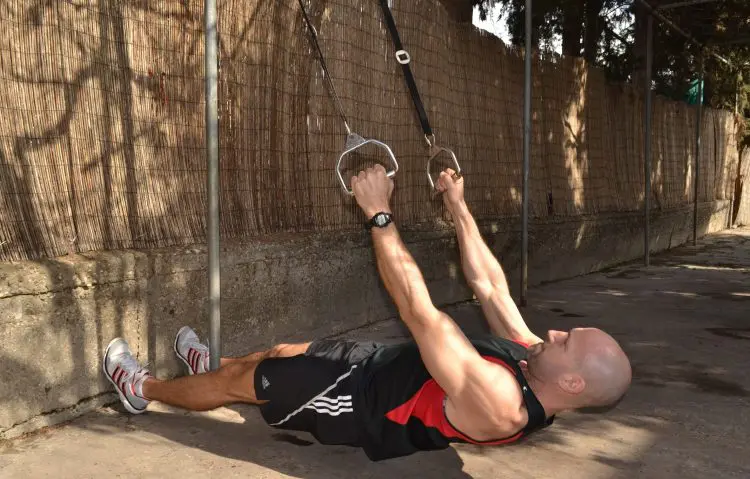
Inverted rows closely mimic bent-over barbell and seated cable rows. They work your lats, mid-traps, rhomboids, posterior deltoids, and biceps. However, they’re also very easy on your lumbar spine, making them beneficial for back pain sufferers.
You’ll need a waist-high bar for this exercise, and you can also use a suspension trainer, such as a TRX or gymnastic rings. However you do it, this is an excellent exercise that will increase upper back thickness.
Take a look at this guide to find out how to do inverted rows.
4. Wall angels
Wall angels are one of the best posture exercises around. They work your mid-traps, rhomboids, and posterior deltoids, and provide your chest with a useful stretch, too. This exercise looks and sounds easy, but it can be quite challenging, especially if you have tight pecs and after the back exercises you’ve already done.
How to do it:
- Stand with your back to a smooth wall, feet about 12-18 inches away from the base. Bend your legs slightly and lean your back and head against the wall.
- Raise your arms, bend your elbows, and press your arms against the wall, so your upper arms are just below parallel with the floor.
- Keeping the back of your hands and arms pressed against the wall, slide your hands up as far as your flexibility allows.
- Lower your arms and repeat.
- Maintain backward pressure with your arms throughout your set.
5. Half locust
The half locust works your erector spinae, especially the muscles of your lower back. This exercise comes from yoga, and as well as strengthening your back, it also helps to mobilize your spine and stretch the muscles on the front of your body, especially your abdominals and hip flexors.
How to do it:
- Using an exercise mat for comfort, lie face down with your arms by your sides, palms flat on the floor.
- Reaching backward with your arms, lift your head, chest, and legs a few inches off the floor. Pull your shoulders down and back.
- Hold for a count of three, return to the starting position, and repeat.
6. Cat-cow stretch
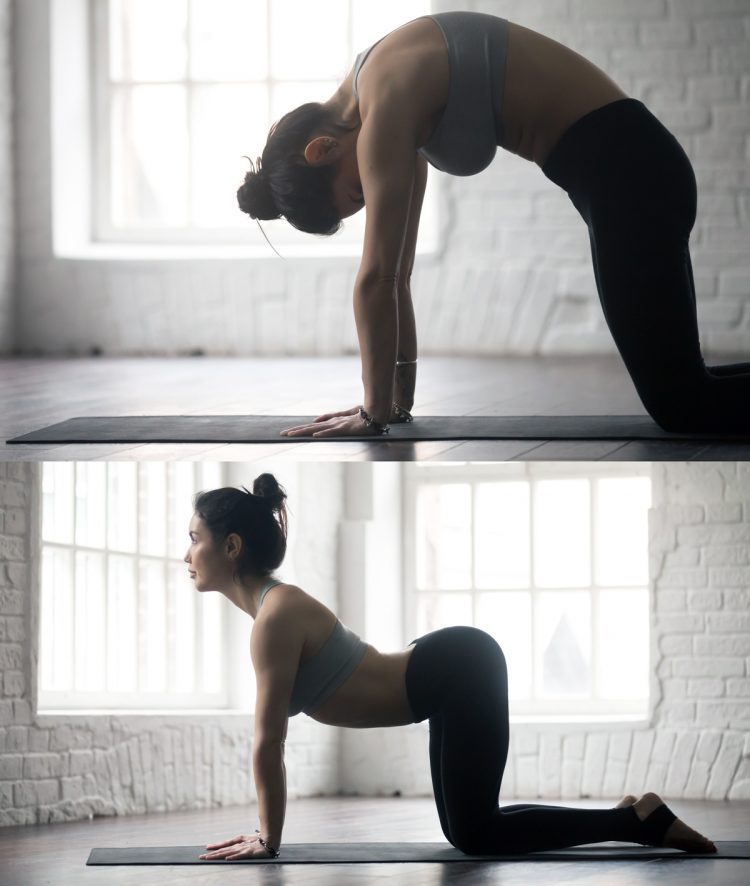
After all the strengthening exercises you’ve done, your back is probably ready for a stretch. The cat-cow is another yoga exercise designed to mobilize your spine and stretch all your major back muscles.
How to do it:
- Kneel on all fours with your shoulders directly over your hands and your hips over your knees.
- Lift your head and your butt, arch your lower back and lower your abdomen down toward the floor.
- Next, lower your head, tuck your butt under, and lift the center of your back up toward the ceiling.
- Slowly and smoothly alternate between these two positions, increasing your range of motion as you feel your spine begin to loosen.
7. 90/90 stretch
The 90/90 stretch is so-called because your hips and knees are flexed to 90-degrees. This exercise provides your spine with a pleasant rotational stretch. Very few daily movements involve rotation, so don’t be surprised if you cannot twist very far. Just stretch as much you can and try to relax; your range of motion will gradually increase.
How to do it:
- Lie on your back with your arms stretched out to the sides to form a T-shape. Bend your knees and hips to 90-degrees.
- Keeping your shoulders flat on the floor, lower your legs over to one side. Hold this position for 20-30 seconds.
- Slowly lift and lower your legs over to the other side. Hold for 20-30 seconds.
- Do 2-4 holds per side.
More on Calisthenics:
- The 11 Best FREE Calisthenics Programs
- Best Calisthenics Triceps Exercises
- The 12 Best Calisthenics Biceps Exercises and Workout
- Hardcore Calisthenics Arm Workout To Build Muscle Mass and Strength
- Calisthenic Shoulder Exercises and Workout
- The Best Calisthenic Leg Workout
- A Routine for Daily Calisthenics Training
- Weighted Calisthenics Best Exercises and Workouts
- Savage Calisthenics Abs Workouts For Beast Gains (All Levels)
- Calisthenics Workout Plan: A Beginner’s Guide
Wrapping Up
Gym-based back workouts are mostly built around exercises like lat pulldowns, bent over and seated rows, and deadlifts. While these are all superb muscle builders, that doesn’t mean they are the only way to increase back strength or size. In fact, you can get a great workout using just your body weight for resistance.
Our calisthenic workout hits your back from all the available angles, ensuring that you’ll not just look stronger, but you’ll be stronger too. It’s a very functional training program. And, as an added benefit, it’s good for your posture, too.
Whether you just need a break from the gym or just prefer to work out at home, this workout will help you build a stronger, more muscular back without weights. Try it; it’s more challenging than it looks!

